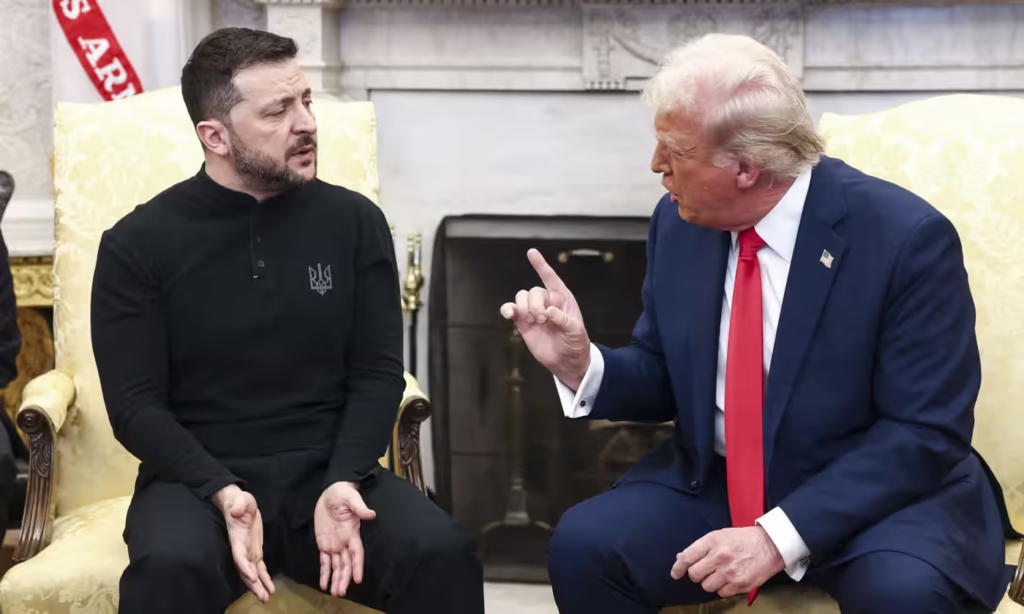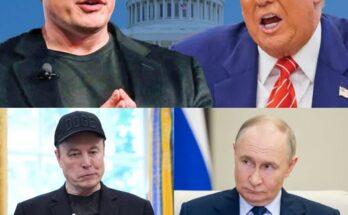The relationship between U.S. President Donald Trump and Ukrainian President Volodymyr Zelenskyy has taken a sharp turn in 2025. The recent high-profile meeting between the two leaders in Washington ended in controversy, leading to the suspension of U.S. military aid to Ukraine. This decision has had significant geopolitical consequences, raising concerns among U.S. allies, Ukrainian officials, and the broader international community. In this report, we analyze the latest developments, their implications, and the potential future of U.S.-Ukraine relations.

1. The Controversial Oval Office Meeting
A Public Dispute
On February 28, 2025, Presidents Trump and Zelenskyy met at the White House for what was initially expected to be a diplomatic discussion about U.S. military and economic support for Ukraine. However, the meeting quickly devolved into a heated debate, with Trump and Vice President JD Vance openly criticizing Zelenskyy for his handling of the ongoing war with Russia.
- Key Issues Discussed:
- U.S. military aid and its effectiveness in Ukraine’s war efforts
- Allegations that Zelenskyy was not negotiating peace with Russia
- Ukraine’s reliance on Western financial support
- Key Takeaways:
- Trump accused Zelenskyy of “failing to explore diplomatic options with Russia.”
- The Ukrainian President, in turn, warned that cutting U.S. aid would strengthen Russia’s position in the war.
- The meeting ended abruptly without any formal agreements.
2. Suspension of Military Aid to Ukraine
A Strategic Shift by the Trump Administration
Following the tense meeting, Trump announced the immediate suspension of all military aid to Ukraine. This decision marked a major departure from the Biden administration’s strong support for Kyiv.
- Reasons Given by Trump:
- The U.S. should focus on “America First” policies and avoid prolonged foreign conflicts.
- Allegations of mismanagement of U.S. aid by the Ukrainian government.
- Trump’s desire to pressure Ukraine into peace negotiations with Russia.
- Impact on Ukraine:
- Ukrainian forces face difficulties in maintaining U.S.-supplied Abrams tanks and other advanced weaponry.
- Shortage of crucial military supplies, including ammunition and anti-aircraft defense systems.
- Increased Russian military advances in eastern Ukraine.
- Response from the Ukrainian Government:
- Zelenskyy condemned the decision, calling it a “betrayal of democratic values.”
- Ukraine intensified its efforts to secure aid from European allies.
3. Trump’s Diplomatic Strategy with Russia
Direct Negotiations with Putin
In another major shift, Trump announced plans for peace talks directly with Russian President Vladimir Putin, without Ukrainian involvement.
- Trump’s Position:
- He argues that continued military aid prolongs the war unnecessarily.
- Believes a negotiated settlement is the best path forward.
- Claims that he can use his personal relationship with Putin to end the conflict.
- Criticism from Ukraine and Allies:
- European leaders fear Trump is making concessions to Russia without securing Ukrainian interests.
- Critics argue that Trump’s approach could embolden Russian aggression.
- The U.S. Congress, particularly Democrats, has opposed the move, calling it “appeasement.”
4. The Fallout and Global Reactions
Reactions from U.S. Allies
- NATO: Expressed concerns that U.S. disengagement could weaken the alliance.
- European Union: Countries like Germany and France have pledged increased military support for Ukraine.
- United Kingdom: The UK reaffirmed its commitment to aiding Ukraine, promising additional military equipment.
Reactions from Russia
- Putin welcomed Trump’s shift in policy, calling it a “step toward peace.”
- Russian state media has portrayed the decision as a victory for Moscow.
Former U.S. Officials Speak Out
- Former National Security Adviser John Bolton warned that Trump is “being manipulated by Putin.”
- Other former officials have called for Congress to intervene and restore aid to Ukraine.
5. Future of U.S.-Ukraine Relations
Potential Outcomes
- Ukraine Seeks New Allies: With diminished U.S. support, Ukraine may turn more to the EU and NATO members for aid.
- Congressional Intervention: Bipartisan support in Congress could lead to legislative action to override Trump’s aid suspension.
- Increased Russian Aggression: With reduced U.S. backing, Russia may escalate its military offensive against Ukraine.
- Trump-Putin Agreement: If peace talks succeed, a controversial deal could be reached, potentially at Ukraine’s expense.
The Road Ahead
- The next few months will be crucial in determining whether Trump’s diplomatic strategy succeeds or backfires.
- Ukraine’s ability to sustain itself militarily will depend on alternative sources of support.
- The 2026 U.S. midterms could shift power in Congress and impact future U.S. foreign policy.
Conclusion
The Trump-Zelenskyy dispute marks a turning point in U.S.-Ukraine relations. While Trump views his diplomatic pivot as a necessary shift towards peace and fiscal responsibility, critics argue that it emboldens Russia and undermines Ukraine’s sovereignty. As global leaders react, the long-term consequences of this policy shift will shape international geopolitics for years to come.


